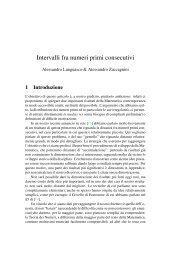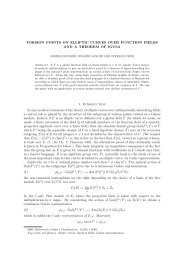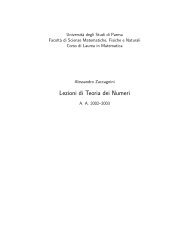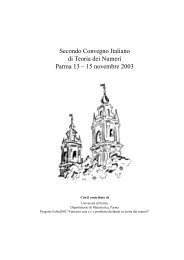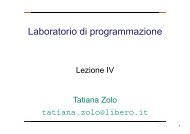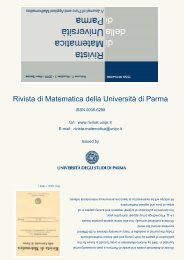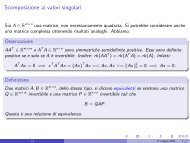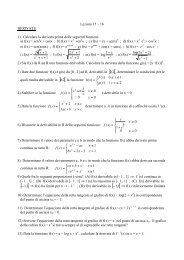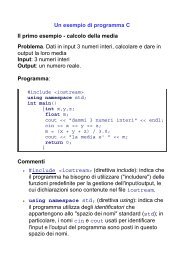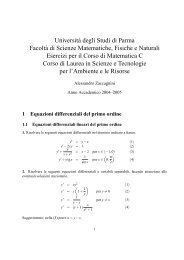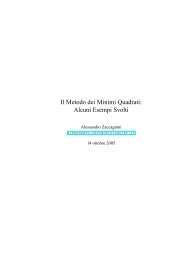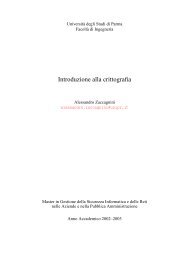<strong>IWASAWA</strong> <strong>THEORY</strong> <strong>OVER</strong> <strong>FUNCTION</strong> <strong>FIELDS</strong> 225.4. Characteristic p L-functions. One of the most fascinating aspects of function fieldarithmetic is the existence, next to complex and p-adic L-functions, of their characteristic pavatars. For a thorough introduction the reader is referred to [18, Chapter 8]: here we justprovide a minimal background.Recall our fixed place ∞ and let C ∞ denote the completion of an algebraic closure of F ∞ .Already Carlitz had studied a characteristic p version of the Riemann zeta function, definedon N and taking values in C ∞ (we will say more about it in section 6.6). More recently Gosshad the intuition that, like complex and p-adic L-functions have as their natural domainsrespectively the complex and the p-adic (quasi-)characters of the Weil group, so one couldconsider C ∞ -valued characters. In particular, the analogue of the complex plane as domainfor the characteristic p L-functions is S ∞ := C ∗ ∞ × Z p , that can be seen as a group of C ∞ -valued homomorphisms on F ∗ ∞, just as for s ∈ C one defines x ↦→ x s on R + . The additivegroup Z embeds discretely in S ∞ . Similarly to the classical case, one can define L(ρ, s) forρ a compatible system of v-adic representation of G F (v varying among places different from∞) by Euler products converging on some “half-plane” of S ∞ .The theory of zeta values in characteristic p is still quite mysterious and at the moment wecan at best speculate that there are links with the Iwasawa theoretical questions consideredin this paper 4 . To the best of our knowledge, the main results available in this direction arethe following. Let F (p)/F be the extension obtained from the p-torsion of a Drinfeld-Hayesmodule (in the simplest case, F (p) is the F 1 we are going to introduce in section 6.1). Gossand Sinnott have studied the isotypic components of A(F (p)) and shown that they are nonzeroif and only if p divides certain characteristic p zeta values: see [18, Theorem 8.14.4] fora precise statement. Note that the proof given in [18], based on a comparison between thereductions of a p-adic and a characteristic p L-function respectively mod p and mod p ([18,Theorem 8.13.3]), makes use of Crew’s result. Okada [36] obtained a result of similar flavorfor the class group of the ring of “integers” of F (p) when F is the rational function field,and Shu [42] extended it to any F ; since Okada’s result is strictly related with the subject ofsection 6.6 below, we will say more about it there.6. Cyclotomy by the Carlitz module6.1. Setting. From now on we take F = F q (T ) and let ∞ be the usual place at infinity, so thatthe ring of elements regular outside ∞ is A := F q [T ]: this allows a number of simplifications,leaving intact the main aspects of the theory. The “cyclotomic” theory of function fields isobtained via Drinfeld-Hayes modules: in the setting of the rational function field the onlyone is the Carlitz module Φ: A → A{τ}, T ↦→ Φ T := T + τ (here τ denotes the operatorx ↦→ x q and, if R is an F p -algebra, R{τ} is the ring of skew polynomials with coefficients inR: multiplication in R{τ} is given by composition).We also fix a prime p ⊂ A and let π ∈ A be its monic generator. In order to underline thefact that A and its completion at p play the role of Z and Z p in the Drinfeld-Hayes cyclotomictheory, we will often use the alternative notation A p for the ring of local integers O p ⊂ F p .Let C p be the completion of an algebraic closure of F p .As usual, if I is an ideal of A, Φ[I] will denote the I-torsion of Φ (i.e., the common zeroesof all Φ a , a ∈ I). One checks immediately that if ι is the unique monic generator of I thenΦ ι (x) =∏(x − u) .u∈Φ[I]4 [Note added in proof] This field is in rapid evolution. After this paper was written, L. Taelman introducedsome important new ideas: see [L. Taelman, Special L-values of Drinfeld modules. To appear in Annals ofMath. 175 (2012), 369–391] and [L. Taelman, A Herbrand-Ribet theorem for function fields. To appear inInvent. Math., Online First DOI: 10.1007/s00222-011-0346-3].
<strong>IWASAWA</strong> <strong>THEORY</strong> <strong>OVER</strong> <strong>FUNCTION</strong> <strong>FIELDS</strong> 23We putF n := F (Φ[p n ])andK n := F p (Φ[p n ]) .As stated in §1.2, we think of the F n ’s as subfields of C p , so that the K n ’s are their topologicalclosures. We shall denote the ring of A-integers in F n by B n and its closure in K n by O n , andwrite U n for the 1-units in O n . Let F := ∪F n and ˜Γ := Gal(F/F ).Consider the ring of formal skew power series A p {{τ}}: it is a complete local ring, withmaximal ideal πA p +A p {{τ}}τ. It is easy to see that Φ extends to a continuous homomorphismΦ: A p → A p {{τ}} (i.e., a formal Drinfeld module) and this allows to define a “cyclotomic”character χ: ˜Γ −→ ∼ A ∗ p. More precisely, let T p Φ := lim Φ[p n ] (the limit is taken with respect to←x ↦→ Φ π (x)) be the Tate module of Φ. The ring A p acts on T p Φ via Φ, i.e., a·(u) n := (Φ a (u n )) n ,and the character χ is defined by σu =: χ(σ) · u, i.e., χ(σ) is the unique element in A ∗ p suchthat Φ χ(σ) (u n ) = σu n for all n. From this it follows immediately that ˜Γ = ∆ × Γ, where∆ ≃ F ∗ p is a finite group of order prime to p and Γ is the inverse image of the 1-units.Since Φ has rank 1, T p Φ is a free A p -module of rank 1. As in [6], we fix a generatorω = (ω n ) n≥1 : this means that the sequence {ω n } satisfiesΦ π n(ω n ) = 0 ≠ Φ π n−1(ω n ) and Φ π (ω n+1 ) = ω n .By definition K n = F p (ω n ). By Hayes’s theory, the minimal polynomial of ω n over Fis Eisenstein: it follows that the extensions F n /F and K n /F p are totally ramified, ω n is auniformizer for the field K n , O n = A p [[ω n ]] = A p [ω n ]. The extension F n /F is unramified atall other finite places: this can be seen directly by observing that Φ π n has constant coefficientπ n . Furthermore F n /F is tamely ramified at ∞ with inertia group I ∞ (F n /F ) ≃ F ∗ q.The similarity with the classical properties of Q(ζ p n)/Q is striking.The formula N Fn+1 /F n(ω n+1 ) = ω n shows that the ω n ’s form a compatible system underthe norm maps (the proof is extremely easy; it can be found in [6, Lemma 2]). This and theobservation that [F n+1 : F n ] = q deg(p) for n ≥ 1 imply(6.1) lim←K ∗ n = ω Z × F ∗ p × lim←U n .Note that lim←U n is a ˜Λ-module.6.2. Coleman’s theory. A more complete discussion and proofs of results in this sectioncan be found in [6, §3]. Let R be a subring of C p : then, as usual, R((x)) := R[[x]](x −1 ) is thering of formal Laurent series with coefficients in R. Moreover, following [11] we define R[[x]] 1and R((x)) 1 as the subrings consisting of those (Laurent) power series which converge on thepunctured open ballB ′ := B(0, 1) − {0} ⊂ C p .The rings R[[x]] 1 and R((x)) 1 are endowed with a structure of topological R-algebras, inducedby the family of seminorms {‖ · ‖ r }, where r varies in |C p | ∩ (0, 1) and ‖f‖ r := sup{|f(z)| :|z| = r}.All essential ideas for the following two theorems are due to Coleman [11].Theorem 6.1. There exists a unique continuous homomorphismsuch thatN : F p ((x)) ∗ 1 → F p ((x)) ∗ 1∏f(x + u) = (N f) ◦ Φ π .u∈Φ[p]



